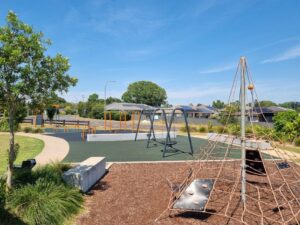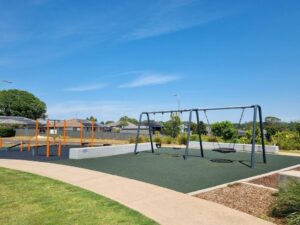
Shade and UV radiation – planting for the future
By Patrick Regnault
Recently, I attended the Australian Institute of Horticulture (AIH) annual conference, where the topic was “Grow Shade Wise”. A particular topic that attracted my attention was ‘Harnessing shade for skin cancer prevention’. There were two speakers, Liz King, Manager of the NSW Skin Cancer Prevention Unit, and Andrew Turnbull, Landscape Architect and Advisor to the Shadesmart working group. The takeaway from those two speakers was the growing importance of creating shade, and natural shade in our designs, particularly in playgrounds and parks.
We can create shade with structures, however, natural shade from plants has the added benefit of cooling the air. Yet, we must remember that not all trees create adequate shade. Even a large eucalyptus can allow a lot of sunlight to penetrate, whereas a smaller ficus will refract UV and create a denser shade area on the floor. Trees reduce irradiance if they obscure both the light and the sky. It does not seem that there are many studies done on UVR and tree species in Australia; the studies I read mostly come from Asia, particularly Korea, North America and Europe. The principal factor is the density of the canopy.

The majority of a person’s UV radiation exposure will happen before they are 18. Creating a shade-smart environment in schools using trees or vegetated structures will go some way towards reducing skin cancer later in life. Unfortunately, too many playgrounds in Australia do not have natural shade. According to a 2021 study by the NSW Cancer Institute, 4 in 5 community playgrounds had at least some shade and 19% no shade whatsoever. This does not tell us the quality or type of shade.
If there is space, it would be very effective and attractive to create a playground within a grove of trees thus creating a cool environment with shade all day.
Outside of playgrounds we also need to create more natural shade. Trees are not the only solution, particularly near underground or above-ground services. Shade can be created by using climbing plants over frames to line streets, thereby creating cool walkways and more liveable green cities.
UV-B is responsible for melanoma and the degradation of synthetic polymer (plastic) and natural polymer (timber) used in construction. Photostabilisers for plastics and surface coating for wood are presently used to mitigate the effect of UV-B. With increased temperatures and possible degradation, even minor, of the ozone layer, the synergistic effect of these factors would further reduce the lifespan of these products that are used so much in our built environment. The replacement cost of these materials alone would be very large indeed. Protection through natural means would help alleviate this costly burden.
Climate change is going to greatly increase the need for shade, and the need to reduce surface heat. Planners must start now designing with shade in mind. We also need to design for UV radiation limitation. We talk about sustainability and biodiversity; creating vegetated shade offers all that and more. The cost of skin cancer to the Australian economy is $1.7 billion annually, yes, $1.7 billion! The savings created by smart planning would reduce this astronomical cost, create jobs and a more liveable environment.
There is a need for planners, architects, builders, teachers, and decision makers at all levels to be aware of the risks and possible mitigations. It is about future-proofing our built environment and the life of upcoming generations. Of course, this would mean a rethink of the planning laws, greater knowledge of plants and an investment in education. Rethinking the future requires investment; business as usual will only lead to failure and greater costs in the medium and long term.
Patrick Regnault FAIH RH0062
Interactive Landscapes
E: patrickregnault@hotmail.com
All images supplied by Patrick Regnault
